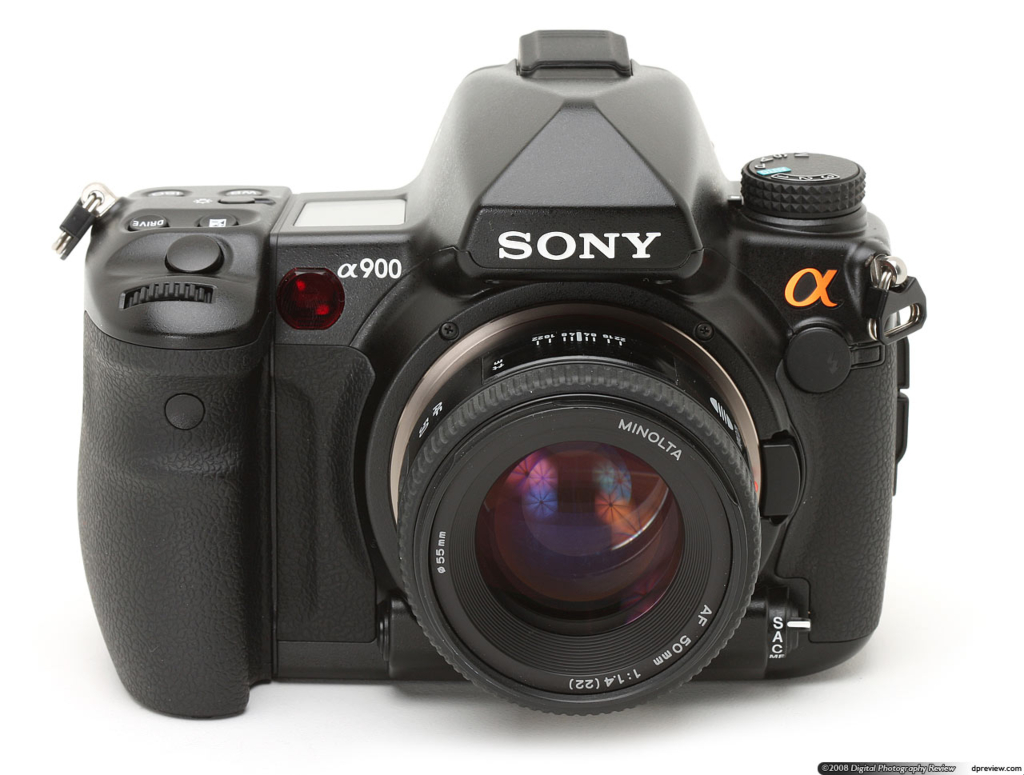
In the cut-throat digital camera market it's increasingly unusual for products to be shown in prototype form or announced more than a matter of weeks before they hit the stores. There's several reasons for the manufacturers' habit of playing their cards so close to their chests, not least that they can't afford to harm sales of the models they've already released. Sony, the newest 'new kid' on the DLSR block, has no such worries, this being its first proper 'high end' DSLR. In fact, if anything the pressure was on the company to show it was committed to becoming a major SLR system player and that it wasn't going to squander Minolta's long legacy in this market after picking up the assets Konica Minolta shed when it pulled out of the photography market. Thus we saw the first prototype of the Alpha 900 - Sony's flagship full frame digital SLR - back in early 2007 (it appeared behind glass at trade shows such as PMA in March 07), and information has been trickling out ever since; most significantly with the announcement in January of this year of a 35mm full frame CMOS sensor.
And so when Sony finally showed the finished Alpha 900 to us a month or so ago there were few surprises at the basic specification or the appearance of the camera. As we started to dig a little deeper, pore over the fine print and actually use the Alpha 900 we were, however, increasingly surprised - and almost always pleasantly so - at some of the decisions made by Sony's engineers when designing its flagship SLR.
The success of the Alpha 900 amongst the Minolta, Konica Minolta and Sony faithful seems assured; at a launch price of just shy of $3000 it offers a lot of 'bang for your buck' and there is undoubtedly a significant number of Minolta film SLR users who've been waiting years for a full frame digital body on which to use their existing lenses. The challenge for Sony, however, is to generate some interest from people without an existing investment in the Minolta (or subsequent Alpha) system. And on paper the Alpha 900 looks promising - and we're already impressed with the build, handling and viewfinder; we'll find out more about how well it actually performs when we finish our full review. For now enjoy this in-depth preview of the latest addition to the small but growing, exclusive full frame DSLR club.
Key features
- 24.6 MP 35mm format full-frame CMOS sensor (highest res in class)
- SteadyShot INSIDE full frame image sensor shift stabilization (world first)
- High Speed Dual Bionz processors
- Eye-level glass Penta-prism OVF, 100% coverage, 0.74x magnification
- 9 point AF with 10 assist points, center dual-cross AF w/2.8 sensor
- 5 frames per second burst, newly developed mirror box
- Intelligent Preview Function
- 3 User programmable custom memory modes on mode dial
- Advanced Dynamic Range Optimizer (5 step selectable)
- 40 segment honeycomb metering
- 3.0" 921K pixel Photo Quality (270 dpi) LCD display, 100% coverage
- Direct HDMI output
- ISO 200-3200 (ISO 100-6400 expanded range)
- User interchangeable focusing screens (3 options)
- CF Type I/II and MS slots, LI-ION battery, STAMINA 880 shots
- Weight 850g (without battery, card, accs)
- New Image Data Converter SR software (includes vignetting control)
- New Vertical Grip
- Supplied with wireless remote control
- Magnesium Alloy body and rubber seals for dust and moisture resistance
- AF micro adjustment
- $2999.99 body price; available late October 2008
Compared to Alpha 700 - key differences
As someone who has used the Alpha 700 extensively I was immediately struck by just how similar its new big brother is; the basic design and layout is almost identical, as are the user interface and the core feature set. Unlike Canon and Nikon, who tend to add further differentiation to their professional products with swathes of extra features and (especially) custom function options, Sony has gone for almost total consistency between the A700 and A900.
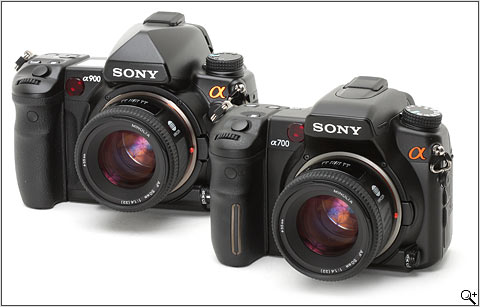
Obviously there are some pretty significant differences both physically and functionally (some of which are upgrades we'd expect to see in the Alpha 700's eventual replacement); aside from the obvious (sensor size/resolution) the key changes are:
- Dual Bionz processors (A700 only has one)
- Three custom modes on mode dial in place of A700's scene modes
- All magnesium alloy construction
- New 9 point AF with 10 assist points for Wide AF mode
- 100% viewfinder coverage (A700 is 95%)
- Improved noise reduction options (including 'off')
- Improved D-Range Optimizer auto function
- No grip sensor or built-in flash
- Top LCD info panel
- Intelligent Preview Mode
- Increased pixel pitch due to improvements in sensor design
 Sony Alpha A900 |
 Sony Alpha A700 | |
| Body material | • Magnesium Alloy body chassis • high grade plastic exterior • Environmental seals |
• Aluminum chassis • Magnesium Alloy body shell • high grade plastic exterior • Environmental seals |
| Sensor | • 35.9 x 24.0 mm CMOS sensor 'Exmor' • RGB Color Filter Array • Built-in fixed low-pass filter • 25.7 million total pixels • 24.6 million effective pixels • On-chip Column A/D Conversion & NR |
• 23.5 x 15.6 mm CMOS sensor 'Exmor' • RGB Color Filter Array • Built-in fixed low-pass filter • 13.05 million total pixels • 12.25 million effective pixels • On-chip Column A/D Conversion & NR |
| Processor | Dual Bionz | Bionz |
| Crop Factor | 1x | 1.5x |
| Image sizes (3:2) | • 6048 x 4032 (24M 3:2) • 4400 x 2936 (13M 3:2) • 3024 x 2016 (6.1M 3:2) • 3924 x 2656 (11M APSC) • 2896 x 1928 (5.6M APSC) • 1984 x 1320 (2.6M APSC) |
• 4288 x 2856 (L RAW) • 4272 x 2848 (L) • 3104 x 2064 (M) • 2128 x 1424 (S) |
| Auto Focus | • TTL CCD line sensors (9-points, center dual cross types + 10 assist sensors) | • TTL CCD line sensors (11-points, 10 lines with center dual cross sensor) |
| Custom modes | Three | Three |
| Bracketing | • Single or continuous bracketing • 3 or 5 frames • 0.3, 0.5 , 0.7 or 2.0 EV steps (2.0 EV steps for 3 exposures only) |
• Single or continuous bracketing • 3 or 5 frames • 0.3, 0.5 or 0.7 EV steps |
| Noise reduction | • Long exposure for exposures longer than 1 second (User controllable: On / Off) • High ISO NR High/Normal/Low/Off at ISO 1600 or higher |
• Long exposure for exposures longer than 1 second (ser controllable: On / Off) • High ISO NR High/Normal/Low at ISO 1600 or higher |
| Continuous | • H: Approx 5fps max • L: Approx 3fps max • RAW: Up to 12 frames • cRAW (compressed): Up to 25 frames • RAW+JPEG: Up to 10 frames • JPEG (XFINE): Up to 11 frames • JPEG (STD/FINE): 285/105 |
• H: Approx 5fps max • L: Approx 3fps max • RAW: Up to 18 frames • cRAW (compressed): Up to 25 frames • RAW+JPEG: Up to 12 frames • JPEG (XFINE): Up to 16 frames • JPEG (STD/FINE): Unlimited (to card capacity) |
| Viewfinder | • Optical glass pentaprism • Spherical Acute Matte focusing screen (interchangeable) • Frame coverage approx 100% • Magnification approx. 0.74x • Eye-relief 20 mm from eyepiece, 21 mm from frame • Eyepiece shutter |
• Optical glass pentaprism • Spherical Acute Matte focusing screen (interchangeable) • Frame coverage approx 95% • Magnification approx. 0.9x • Eye-relief 25 mm from eyepiece, 21 mm from frame |
| Vertical Grip | Optional vertical Grip VG-C90AM | Optional vertical Grip VG-C70AM |
| Dimensions | 156 x 117 x 82 mm | 141.7 x 104.8 x 79.7 mm |
| Weight | • No battery: 850 g • With battery: 895 g |
• No battery: 690 g • With battery: 768 g |
| Other | • Intelligent Preview mode • New raw converter software • AF Micro Adjustment • Top LCD panel |
• Grip sensor |
![]()
Sony Alpha DSLR-A900 Specifications
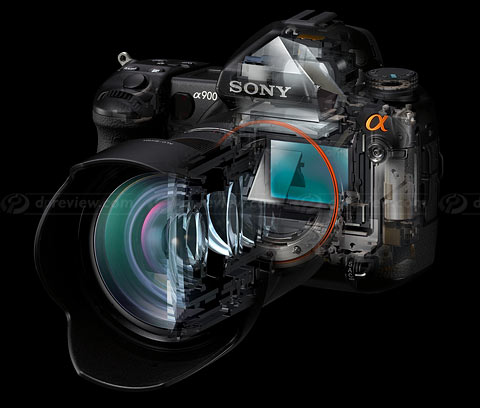
| Price (body only) |
• $2999.99 |
|---|---|
| Body material | Magnesium Alloy chassis, high grade plastic exterior |
| Sensor | • 35.9 x 24.0 mm CMOS sensor 'Exmor' • RGB Color Filter Array • Built-in fixed low-pass filter • 25.7 million total pixels • 24.6 million effective pixels • On-chip Column A/D Conversion & NR |
| Image sizes |
• 6048 x 4032 (24M 3:2) |
| File qualities / formats | • RAW (.ARW 2.0) • Compressed or uncompressed RAW option • RAW + JPEG Fine • JPEG Extra Fine • JPEG Fine • JPEG Standard |
| Dust reduction | • Static-resistant anti-dust coating • CCD-shift dust reduction mechanism |
| Lenses | • Sony Alpha lenses (also compatible with Minolta A-type bayonet mount lenses) • Can be used with DT (1.5x crop) lenses in APS-C mode |
| FOV crop | 1.0 x |
| Image Stabilization | • CCD-Shift ' SteadyShot INSIDE' system • Five level LED shake indicator in viewfinder • Claimed equivalent to 4 steps in shutter speed * |
| Auto Focus | • TTL CCD line sensors (9-points, center dual cross types + 10 assist sensors) • EV 0 to 18 (ISO 100) detection range • Predictive focus control for moving subjects |
| AF area selection |
• Wide AF area |
| Focus modes | • Single-shot AF • Direct Manual Focus • Continuous AF • Automatic AF • Manual focus • AF micro adjustment (+/- 20 steps for up to 30 lenses) |
| AF assist illuminator |
• Yes (built-in LED lamp) • Range approx 1m - 7m |
| Eye-start AF | No |
| Shooting modes |
• Auto |
| Sensitivity |
• Auto (200 - 3200) - upper/lower limit selectable * |
| Metering modes | • Multi-segment (40 segment Honeycomb pattern) • Center-weighted • Spot |
| Metering range | • EV 0 to 20 (Multi-segment / Center-weighted) • EV 2 to 20 (Spot metering) (at ISO 100 with F1.4 lens) |
| AE Lock | • AEL button (customizable) • Half-press shutter release |
| AE Bracketing | • Single or continuous bracketing • 3 or 5 frames • 0.3, 0.5, 0.7 or 2.0 EV steps* *2.0 EV steps for 3 frames only |
| Exposure compen. | • -3.0 to +3.0 EV • 0.3 or 0.5 EV steps |
| Shutter | Electronically-controlled, vertical-traverse, focal-plane Shutter |
| Shutter Speed | • 30 to 1/8000 sec • Bulb |
| Flash X-sync | • 1/250 sec • 1/200 sec (with SteadyShot INSIDE on) |
| Aperture values | Depends on lens, 0.3 EV steps |
| DOF preview | Yes, dedicated button |
| White balance |
• Auto |
| White balance fine tuning | • Auto (none) • Preset WB: -3 to +3 • Fluorescent WB: -2 to +4 • Color temperature WB: G9 to M9 (19 step Magenta / Green compensation) |
| White balance bracketing | • 3 frames • Hi or Lo steps |
| Dynamic range optimizer |
• Off |
| Color space | • sRGB • Adobe RGB |
| Color modes | • Standard • Vivid • Neutral • Clear • Deep • Light • Portrait • Landscape • Sunset • Night view • Autumn Leaves • B&W • Sepia • Adobe RGB |
| Image parameters | • Contrast (-3 to +3) • Saturation (-3 to +3) • Sharpness (-3 to +3) • Zone Matching (-1 to +2 steps) • Brightness (-3 to +3 steps) (Available in all color modes) |
| Noise reduction | • Long exposure for exposures longer than 1 second (User controllable: On / Off) • High ISO NR High/Normal/Low/Off at ISO 1600 or higher |
| Viewfinder |
• Eye-level fixed optical glass pentaprism |
| LCD monitor | • 3.0 " 'Xtra Fine' TFT LCD • 921,600 pixels (640 x 480 x 3 (RGB)) • 100% coverage • Anti-reflective coating |
| Flash compensation | -3.0 to +3.0 EV in 0.3, 0.5, 0.7, 2.0 EV steps |
| External flash (optional) | • Sony HVL-F58M • Sony HVL-F56M • Sony HVL-F42M • Sony HVL-F36M • Macro Twin Flash Kit HVL-MT24AM • Ring Light HVL-RLAM • Off camera flash shoe FA-CS1 AM |
| Drive modes | • Single-frame • Continuous (H/L selectable) • Self-timer (10 or 2 sec) • Continuous bracket • Single-frame bracket • White balance bracket • DRO bracket |
| Continuous shooting * |
• H: Approx 5fps max • L: Approx 3fps max • RAW: Up to 12 frames • cRAW (compressed): Up to 25 frames • RAW+JPEG: Up to 10 frames • JPEG (XFINE): Up to 11 frames • JPEG (STD/FINE): 285/105 |
| Self-timer |
• 10 sec |
| Orientation sensor | Yes, for shooting, playback and control panel display |
| Connectivity | • USB 2.0 Hi-Speed (mass storage, Multi-LUN or PTP) • Video out (NTSC or PAL) • HDMI type C mini jack • DC-IN • Remote terminal • PC control (with supplied software) |
| Remote control * | • Wired: with optional RM-S1AM or RM-L1AM • Wireless: with included remote control |
| Video out | • AV (Selectable NTSC or PAL) • HDMI (1920 x 1080i, 1280 x 720p, 720 x 580p, 720 x 576p) • 'PhotoTV' HD settings applied with BRAVIA. |
| Storage | • Compact Flash Type I/II, UDMA Mode 5 compliant • Memory Stick Duo / Pro Duo, PRO-HG Duo • Supports FAT12 / FAT16 / FAT32 |
| Power | • NP-FM500H Lithium-Ion rechargeable battery (1650 mAh) • CR2025 Wireless remote • Battery charger included • Optional AC adapter • Batter life Approx 880 shots (CIPA standard) |
| Vertical grip | • Vertical Grip VG-C90AM • One or Two NP-FM500H batteries with auto switchover for power (additional battery is optional). |
| Dimensions | 156 x 117 x 82 mm |
| Weight (body) | • No battery: 850 g • With battery: 895 g |
What's new/key features (highlights)
 |
 |
|
24.6 megapixel APS-C 'Exmor' CMOS Once again the sensor uses on-chip column A/D processing (there are over 6000 parallel analog/digital converters on the sensor) and once again there is a two stage noise reduction system - both before and after the A/D conversion. |
Dual Bionz Image Processors |
 |
 |
| Anti-Blur Well, a lot of people said it wasn't possible, but Sony has managed to produce a sensor-shift SteadyShot image stabilization system with a full frame sensor. Its actuator is 1.5x more powerful and 1.3x faster than previous models, and is claimed to offer an up to 4 stops advantage. It's compatible with all lenses. The CCD shift is also used (in conjunction with a special anti-static coating on the sensor) to offer a dust removal feature. | |
 |
 |
| New AF Sensor The Alpha 900 features a new center dual-cross, 9 point AF system with an additional 10 (assist) sensors used when Wide AF is selected. There is an additional F2.8 sensor in the middle for higher accuracy with fast lenses. Sony is claiming improved tracking accuracy and focus speed (it's interesting to note that the AF area covered is rather squashed in the middle - perfectly fitting into a cropped sensor area, suggesting it may well find use in future models). |
High Speed shutter Carbon fibre shutter offering 1/8000 sec top speed and 1/250th sec x-sync (1/200th if SteadyShot is on). Sony is quoting a 100,000 shutter cycle life. |
 |
 |
| Newly Designed Mirror Box The Alpha 900 has a big mirror (full frame and 100% coverage kind of precludes anything smaller), so Sony has designed a totally new mirror box that uses a clever 'Parallel Link' system to raise the mirror (rather than simply swinging it) without the need for a considerably deeper body. The mechanism itself features a newly developed moving magnet actuator, coreless motor and magnetic catcher (to minimize bounce) - all of which help the Alpha 900 achieve its impressive 5.0 fps shooting speed. | |
 |
 |
| Top info panel Unlike the 700, the Alpha 900 has a small (and to be honest, almost redundant) info panel which displays battery life, remaining shots, aperture/shutter speed and AE compensation status, and can be used to change ISO, WB, and Drive modes too. |
Optical Pentaprism |
 | |
|
Aluminum chassis/Magnesium body | |
 |
 |
| X-Fine 3.0" LCD The Alpha 900 has what appears to be exactly the same Xtra-Fine 3.0" LCD screen as the A700. With 922,000 (well, 640 x 480 x RGB) pixels it has a resolution of 270ppi, plus high contrast and a wide viewing angle. |
Intelligent Preview |
 |
 |
| Custom Register Rather than the Alpha 700's range of scene modes the 900 has three considerably more useful (and certainly more versatile) user-programmable memory modes. These are accessible directly from the mode dial. |
Dual Storage Formats |
 |
 |
| New lenses The A900 is launched with two new full frame lenses, the 70-400mm F4-5.6 G SSM and this very nice Zeiss Vario-Sonnar T* 16-35mm F2.8 ZA SSM. Incidentally you can use Sony/ Minolta crop lenses (DT) on the Alpha 900 by switching on the 'crop mode' option. |
New Vertical Grip |
Design
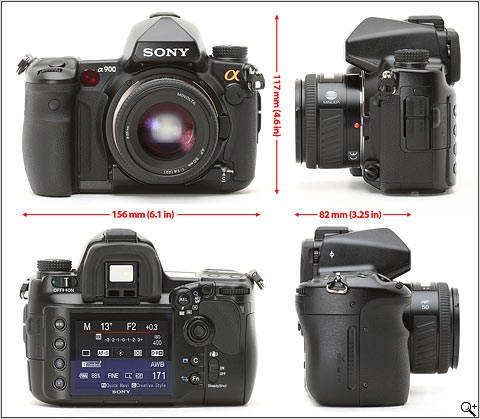
We're big fans of consistency across camera ranges and the Alpha 900 is - aside from the rather old-school pentaprism design and more solid build quality - surprisingly similar to its little brother, the Alpha 700. It may not be the prettiest camera ever designed (all a matter of opinion of course) but it is incredibly well built and has a clean, logical and functional layout that marries a sensible level of external control (there's a rash of buttons all over the body) with an excellent on-screen control system.
I have to say that we're very impressed with the A900's tank-like build and (relatively speaking) low weight. It handles incredibly well, which combined with the responsiveness and superb viewfinder, make it a pleasure for the serious photographer to use. Sure there are some niggles (some of the button placement could be better) but overall this feels like a mature, intuitive and unpretentious tool designed first and foremost for taking pictures. I can only presume the DSLR team has never met the guys behind the current range of Cyber-shot cameras... and I hope they never do.
In your hand
It's not a small camera, but for someone who has just spent several months using the Canon EOS-1Ds Mark III and Nikon D3 the Alpha 900 feels far more 'portable'. Handling is generally excellent, and you rarely get the feeling that the camera is 'getting in the way' of your photography (this helped by the fact it's actually a lot less complicated than some of its competitors). They may not have pushed the boat out when it came to the visual appearance of the Alpha 900, but Sony's designers certainly thought about how the camera sits in your hand, which I guess is more important.
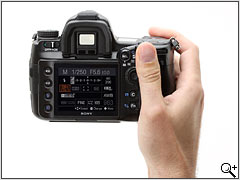
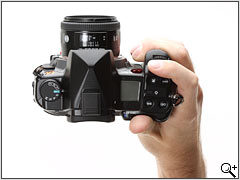
Side by side
We'll look more closely at how the A900 compares with its direct competitors when we complete our full review, but as the shot below shows, it's fractionally larger than the EOS 5D - but only because of that huge lump of glass on top - and it's a lot lighter than the Nikon D700.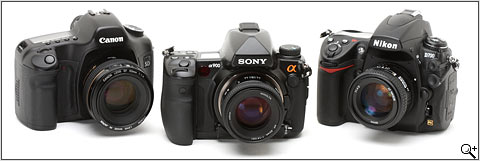
| Camera | Dimensions (W x H x D) |
Body weight (inc. battery & card) |
|---|---|---|
| Sony Alpha DSLR-A900 | 156 x 117 x 82 mm (6.1 x 4.6 x 3.25 in) | 895 g (2.0 lb) |
| Canon EOS 5D | 152 x 113 x 75 mm (6.0 x 4.4 x 2.9 in) | 895 g (2.0 lb) |
| Nikon D700 | 147 x 123 x 77 mm/5.8 x 4.8 x 3.0 in. | 1075 g/2.36 lb. |
LCD Monitor
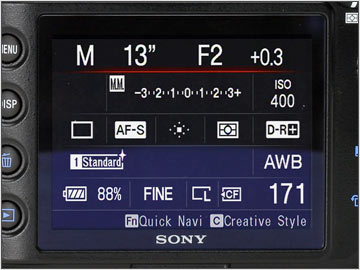
The A900 features the same 3.0 inch 'XFine' TFT monitor as the Alpha 700, boasting 922,000 pixels (640x 3 (RGB) x 480). Again, we have to say, it's very, very impressive; sharp, detailed and contrasty, but it's the resolution that really catches your eye. At 270 ppi it's basically impossible to see the pixels with the naked eye, and the visual effect is similar to a good photo print. This makes checking focus in playback a lot easier without the need to zoom right in, and simply makes viewing saved pictures a real treat. We've seen LCD sizes creeping up over the last few years but the latest screens (featured on cameras such as the Alpha 900, Nikon D300 and Canon EOS 50D) represent a breathtaking step forward in quality. Very, very nice.
The GUI uses high resolution, beautifully aliased fonts and graphics to give an almost 'print like' quality that is easy on the eye even if it doesn't really make any difference to the actual taking of pictures (nothing wrong with that - I like the 11 speaker system in my car, but it doesn't make it go any faster).
Like the A700 the A900's screen has a pretty effective anti-reflective coating, and like the A700 you'll find yourself wiping smears from it pretty much every time you look at it.
Recording mode display
Once again the A900 uses the LCD monitor to provide a virtual control panel which summarizes camera settings (there are two levels of detail) and rotates automatically when the camera is placed in the portrait orientation, and which allows you to access the information shown in the display and change settings directly from there (more of which later).
A full breakdown of available information is shown in the diagrams below (camera in horizontal orientation on left, vertical orientation on the right). Note that the diagrams are in the most detailed mode.
Information (advanced mode)
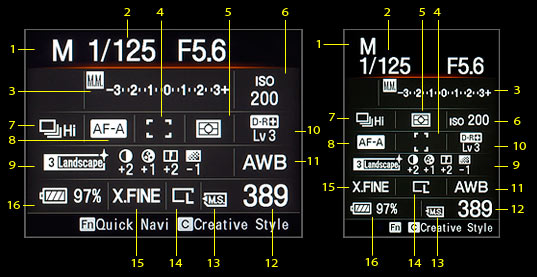
- Exposure Mode
- Shutter Speed / Aperture
- EV scale / Exp comp. / Flash comp.
- Focus Area mode
- Metering Mode
- Sensitivity (ISO)
- Drive mode
- AF mode
- Creative Style
- Dynamic Range Optimizer setting
- White Balance
- Frames remaining
- Memory Card
- Size
- Quality
- Battery level
Viewfinder
Aside from the headline-grabbing sensor there's no doubt that the single feature Sony decided to concentrate on with the Alpha 900 was the viewfinder (even the design looks like the entire camera was built around the prism). And what a viewfinder it is; with 100% field of view and an incredibly bright, clear image it sets a new standard for this class of camera that I can't see being improved upon in the near future. The eye relief is a little tight (you need to get pretty close to see the entire engulfing view), but boy is it worth it. Start using the Alpha 900 'in the field' and you soon forget about fripperies like live view and simply enjoy the experience of a truly involving photographic experience. There's the usual dioptre adjustment and an eyepiece shutter, plus eye-start sensors (which are simply used to kill the rear LCD monitor - there's no eye-start focus)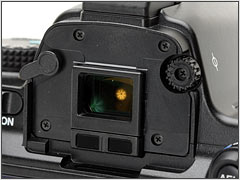
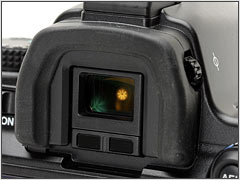
Viewfinder view
Through the viewfinder you will see the center spot-metering circle and 9 main AF areas indicated. The selected / in-use AF area(s) is/are indicated on a half-press of the shutter release with a red glow. The 'Anti-Shake scale' indicates how much the camera is having to compensate for movement, this is obviously a combination of the current actual movement, focal length and shutter speed, ideally you should be aiming to keep this as low as possible. The viewfinder display is very similar to the A700, and still doesn't show things like ISO, white balance or drive mode unless you're currently changing them (when, to be fair, it does so in a relatively clear manner).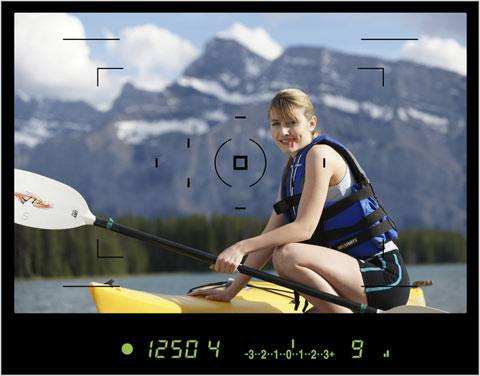
LCD control panel
The biggest functional change over the Alpha 700 is the inclusion of a small LCD control panel squeezed between the gargantuan pentaprism and the control buttons on the top of the camera. To be honest I rarely used it - this is partly because the superb interface and Quick Navi system on the main screen is so superb, and partly because the top LCD is about as sophisticated as an early 80's hand-held frogger game. It's great for checking shutter speed, aperture and frames remaining, or whether you've got an AE compensation set (the only icon on the panel is the +/- indicator), at a glance - but not a lot else.
If you hold down any of the direct access keys (such as ISO, WB) you can see what's currently set (and change the setting using the dials), but they're not permanently displayed. The fact that the display appears to be based on a dime store digital watch also means that the values are displayed in what is occasionally rather crude and far from immediately obvious manner (High speed continuous, for example, appears as 'oooH') - there are very few icons. Still, I'm sure there'll be plenty of users happy to see an LCD on the top panel, even if it is verging on the redundant.
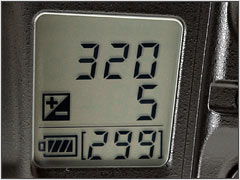
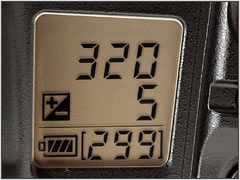
Battery / Battery Compartment
The A900 features the same NP-FM500H InfoLITHIUM battery as the A700. The battery is charged in around 175 minutes (235 minutes for a 'full charge') using the supplied charger (which can also act as a mains adapter for the camera if you buy an optional cable). Battery life is quoted as 880 shots (using the CIPA standard), something we'll be able to comment on a little more when we've had more time using the camera.
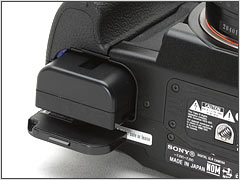
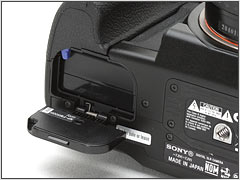
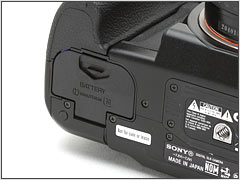
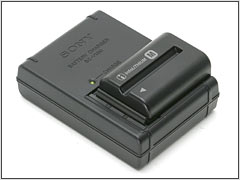
Compact Flash Compartment
Like its little brother, the Alpha 900 offers dual CompactFlash and Memory Stick Duo slots. The card compartment door is located on the right side of the camera and forms part of the hard grip. The door is spring loaded and flips open once slid back. Inside is the Compact Flash Type II card slot which can accept Type I or Type II cards (including FAT32 cards) and a smaller Memory Stick DUO slot. If both are inserted a menu option allows you to choose which is used for recording/playback. What you can't do is any of the clever stuff offered by other manufacturers (auto switchover, backup, splitting raws and JPEGs etc).
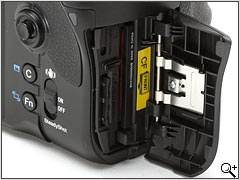
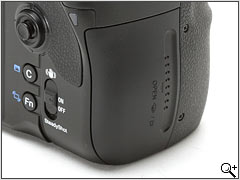
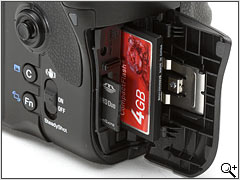
Connections / Accessory shoe
The A900's connectors are gathered together on the left side of the camera (looking from the rear) under very sturdy (and quite rigid) rubber flaps on proper hinges. At the front you'll find the x-sync socket (for studio flash), remote commander port (for the optional Minolta-standard remote) and DC-in socket. Behind these are a mini USB port (combined data and video out) and the mini HDMI socket for HDTV. On the top of the camera is the Minolta standard accessory shoe. The A900 supports USB 2.0 Hi-Speed (up to 480 Mbps).
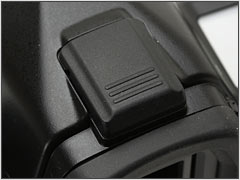
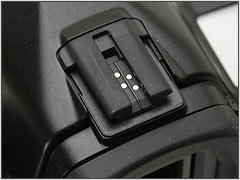
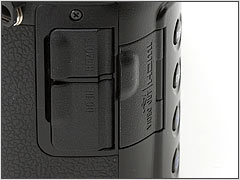
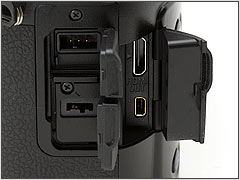
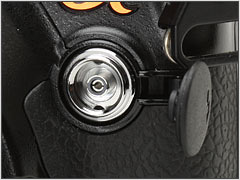
Lens Mount
No surprises here, a standard Minolta A-type bayonet lens mount. As usual there is a red indicator dot for aligning the lens and lock by rotating clockwise. Just like other Minolta AF SLR's the camera goes through a priming process when a len is attached by spinning the focus motor connector to ensure it has connected correctly to the lens. This mount supports either body driven focus or lenses with built-in focus motors. Of course the big difference here is that huge mirror - and behind it that huge expanse of sensor.
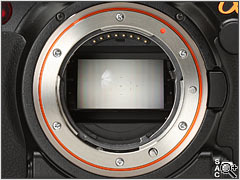
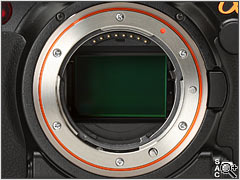
Using DT (crop) lenses
The Alpha 900 is quite happy working with lenses designed for the APS-C (cropped sensor) models. The camera detects when such lenses are attached and automatically crops images taken (the image size menu changes to reflect this; you can select up to 11 MP only). What it doesn't do is crop or mask the viewfinder, nor is there any indication at all that you've got a DT lens attached. The APS-C crop is indicated on the focusing screen (see below), but that's it. With most lenses you'll see some vignetting in the viewfinder especially at wide angle settings (the 18-70mm DT for example, vignettes at anything below about 24mm.
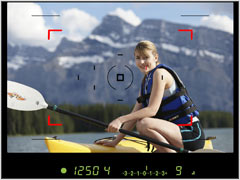
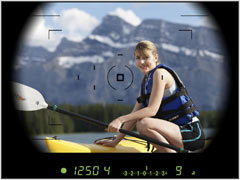
Vertical Grip
With the introduction of the A900 comes a new vertical grip, the VG-C90AM. The grip powers the camera using one (or optionally two) NP-FM500H batteries (again, no luck for owners of NP-FM55 batteries) and is attached by removing the battery from the camera. There is a small slot in the body of the grip to accommodate the A700's battery compartment door (in other words you don't have to take the door off). The grip has a vertical shutter release that is positioned lower than normal so it still lines up with the top of the lens and the viewfinder, meaning the camera feels remarkably similar whichever orientation you use it in. I have to say, handling with the VG-C90 attached is excellent.
The grip has a full complement of switches and buttons to replicate those on the rear of the camera, meaning when it is attached the A900 has well over 30 buttons, switches and dials on the exterior of the body
Controls built into the Vertical Grip
- Fn (Function) button
- C (Custom) button
- Multi Controller
- AEL / Slow Synch / Spot meter button
- AF/MF button
- AE-Compensation button
- On/Off switch
- Twin (front and rear) control dials.
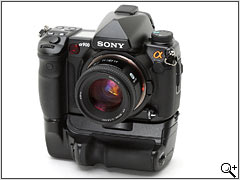
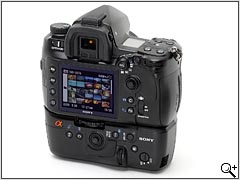
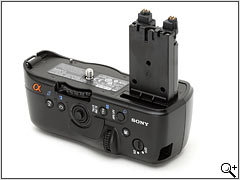
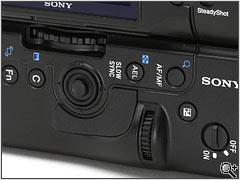
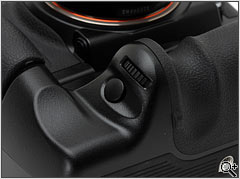
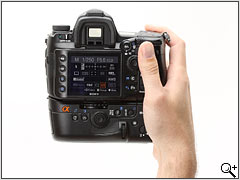
Box Contents (body only)
- Sony Alpha A900 digital SLR body
- NP-FM500H Lithium-Ion battery
- Battery charger (full charge time approx. 235 minutes)
- Eyepiece cup
- Body cap
- Shoe cap
- Shoulder strap
- Video and USB cables
- Software CD-ROM
- Manual, Warranty
Samples Galleries
There are 30 images in the samples gallery. Please do not reproduce any of these images on a website or any newsletter / magazine without prior permission (see our copyright page). We make the originals available for private users to download to their own machines for personal examination or printing (in conjunction with this review), we do so in good faith, please don't abuse it.
Unless otherwise noted images taken with no particular settings at full resolution. A reduced size image (within 1024 x 1024 bounds) is provided to be more easily viewed in your browser. As always the original untouched image is available by clicking on this reduced image.
Important note: Some of the images in this gallery were taken with an early pre-production camera and may not reflect the final image quality (though to us they seem fairly close). Sony has kindly allowed us to publish these shots on the understanding that we do so only with this warning, and with the EXIF stripped from the files. The preproduction samples are clearly indicated in the gallery (and the filenames end with 'PP').
Note: apologies for the lack of wideangle/nice weather shots. In the short time we've had the Alpha 900 there's been a distinct lack of blue skies (oh and two really really nice fast tele primes to play with).
Sony Alpha 900 Preview Samples (1 of 39), 85 mm equiv, ISO 400, 1/50 sec, F2.0, +0.0 EV, Sony 85mm F1.4 Zeiss ZA
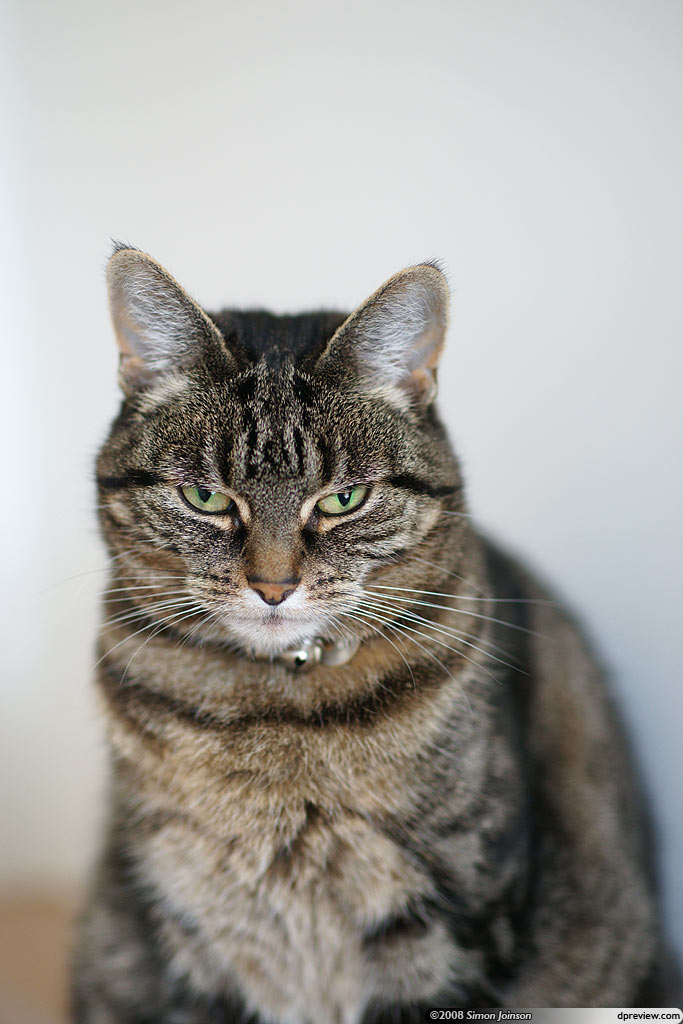
Sony Alpha 900 Preview Samples (2 of 39), 85 mm equiv, ISO 800, 1/1250 sec, F2.0, +0.0 EV, Sony 85mm F1.4 Zeiss ZA
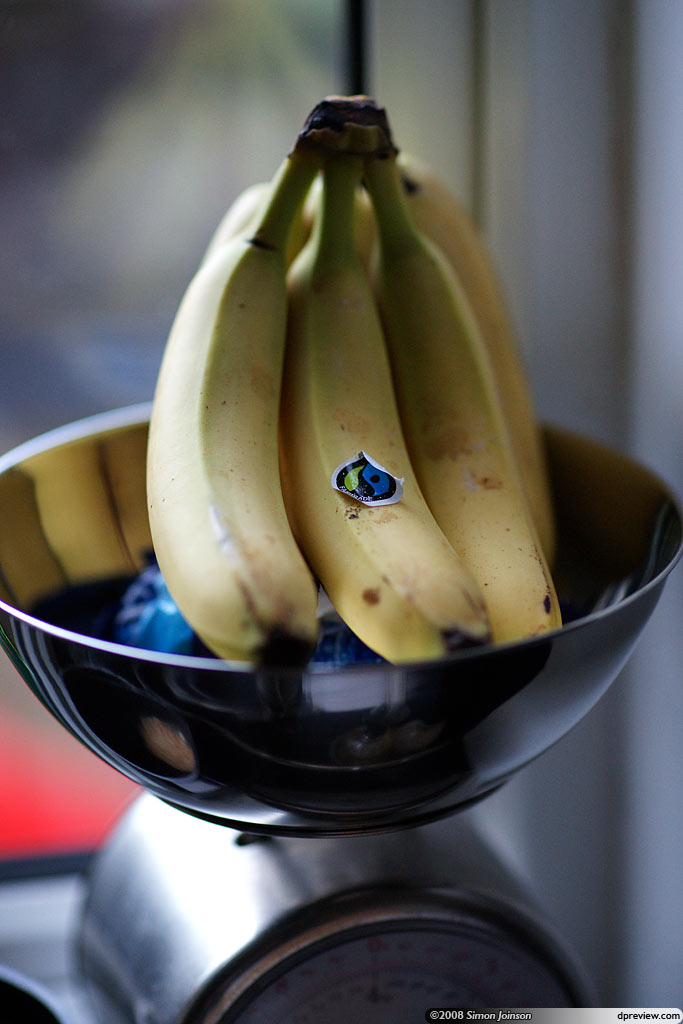
Sony Alpha 900 Preview Samples (3 of 39), 85 mm equiv, ISO 400, 1/200 sec, F2.8, +0.0 EV, Sony 85mm F1.4 Zeiss ZA

Sony Alpha 900 Preview Samples (4 of 39), 70 mm equiv, ISO 400, 1/1250 sec, F2.8, +0.0 EV, Beta Camera / Sony 24-70mm f2.8 ZA
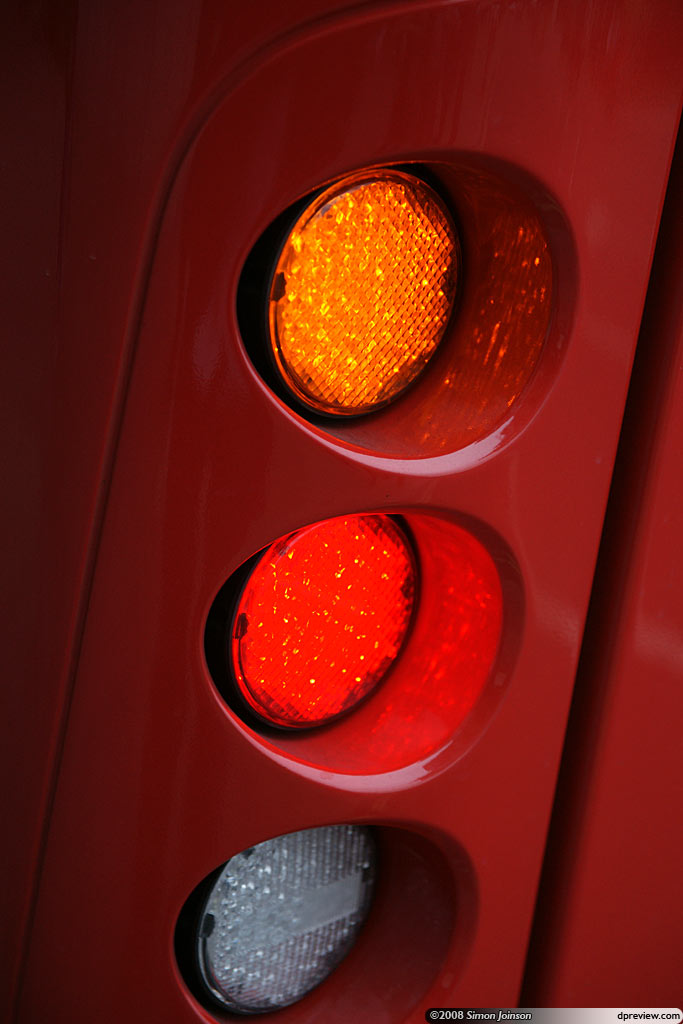
Sony Alpha 900 Preview Samples (5 of 39), 30 mm equiv, ISO 800, 1/80 sec, F2.8, +0.0 EV, Sony 24-70mm f2.8 ZA
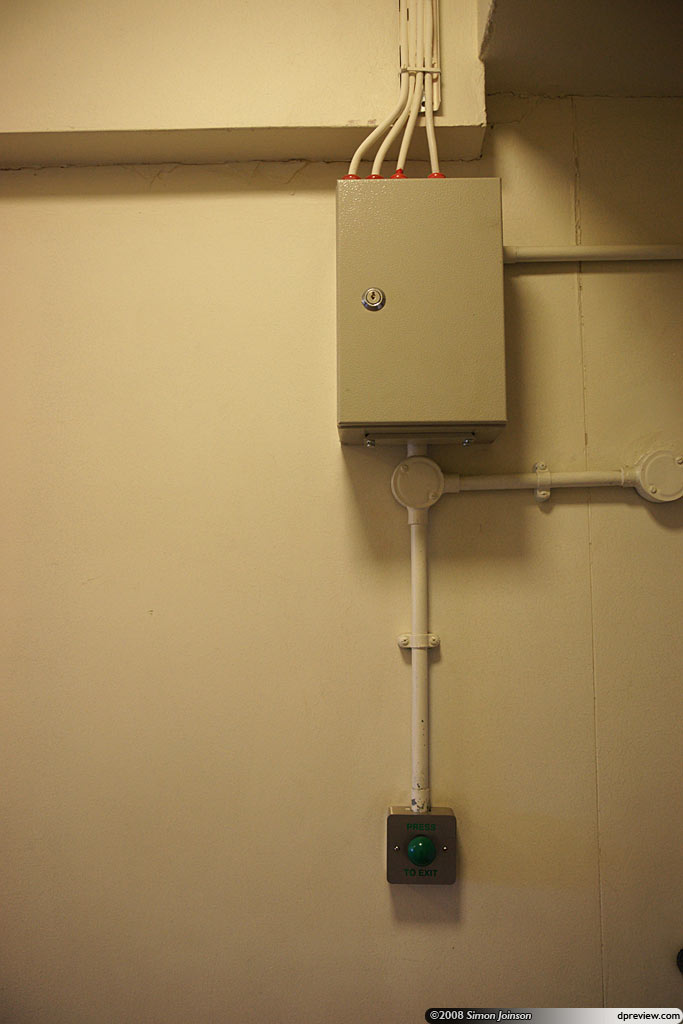
Sony Alpha 900 Preview Samples (6 of 39), 70 mm equiv, ISO 1600, 1/640 sec, F11.0, +0.0 EV, Sony 24-70mm f2.8 ZA

Sony Alpha 900 Preview Samples (7 of 39), 70 mm equiv, ISO 250, 1/640 sec, F8.0, +0.0 EV, Sony 24-70mm f2.8 ZA
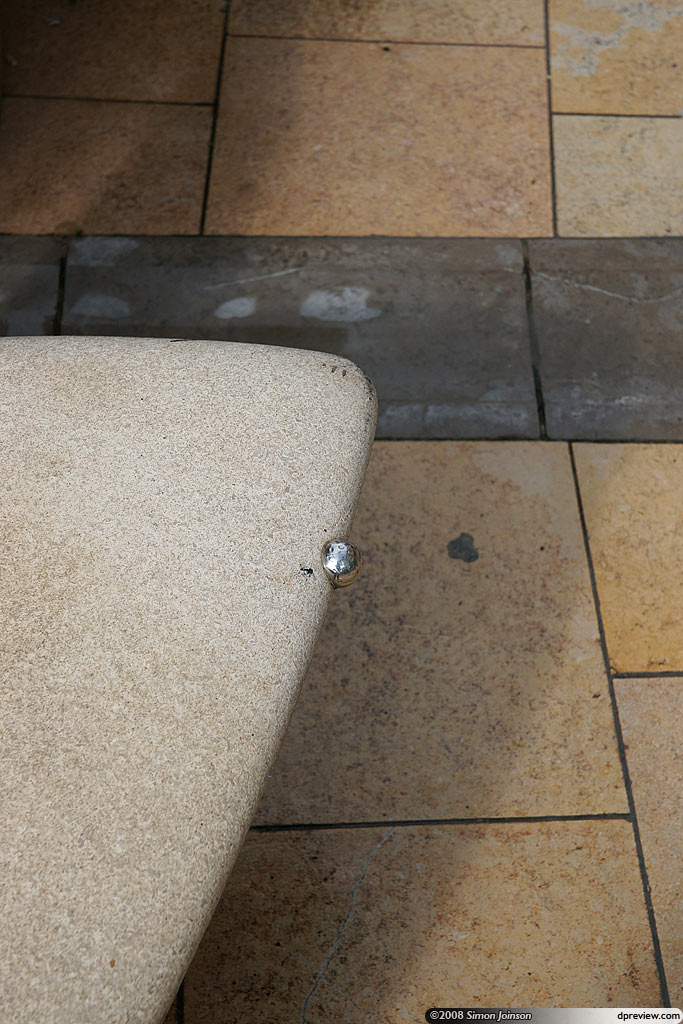
Sony Alpha 900 Preview Samples (8 of 39), 70 mm equiv, ISO 400, 1/640 sec, F2.8, +0.0 EV, Beta Camera/Sony 24-70mm f2.8 ZA
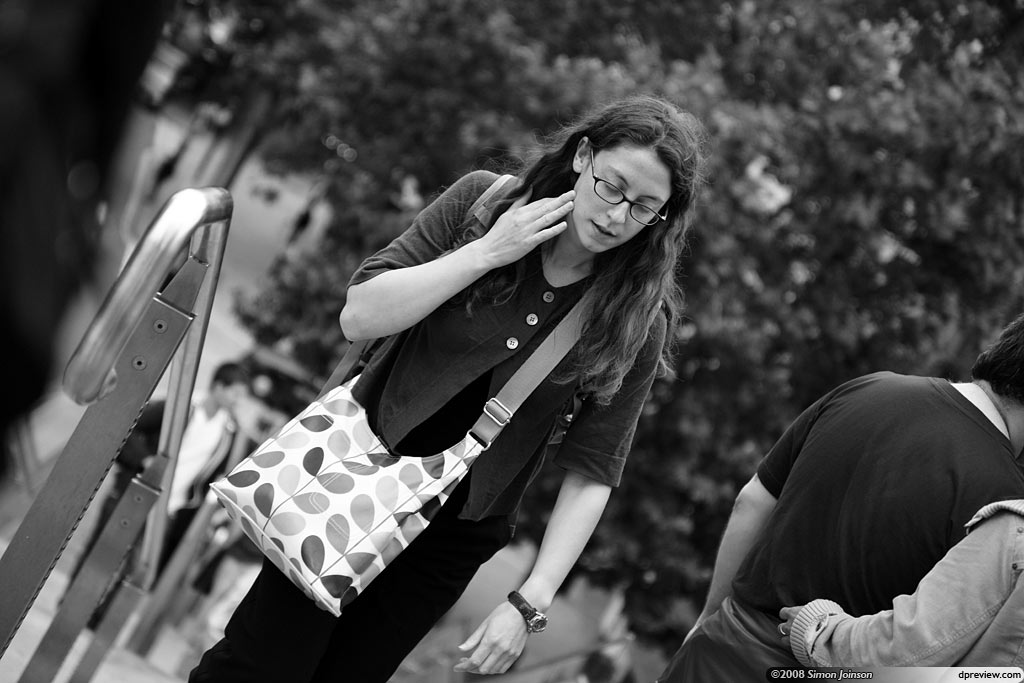
Sony Alpha 900 Preview Samples (10 of 39), 70 mm equiv, ISO 6400, 1/640 sec, F2.8, +0.0 EV, Sony 24-70mm f2.8 ZA
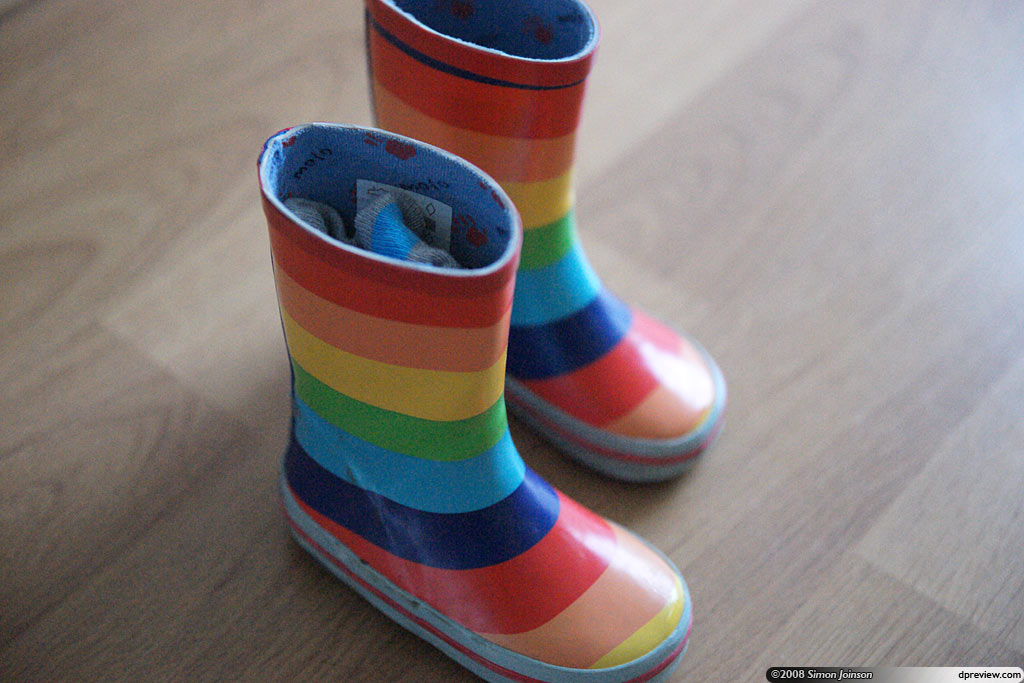
Sony Alpha 900 Preview Samples (16 of 39), 135 mm equiv, ISO 100, 1/60 sec, F4.0, +0.3 EV, Beta Camera / Sony 135mm F1.8 ZA
Sony Alpha 900 Preview Samples (22 of 39), 135 mm equiv, ISO 800, 1/40 sec, F2.0, +0.3 EV, Beta Camera / Sony 135mm F1.8 ZA
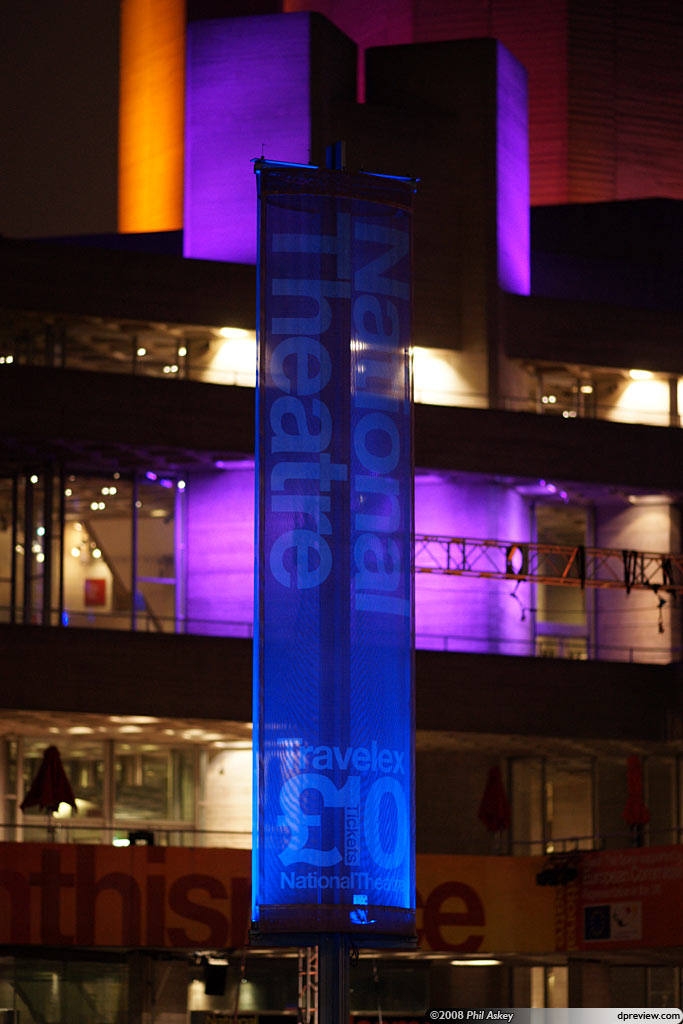
Sony Alpha 900 Preview Samples (34 of 39), 135 mm equiv, ISO 200, 1/500 sec, F4.5, +0.0 EV, Sony 135mm F1.8 ZA
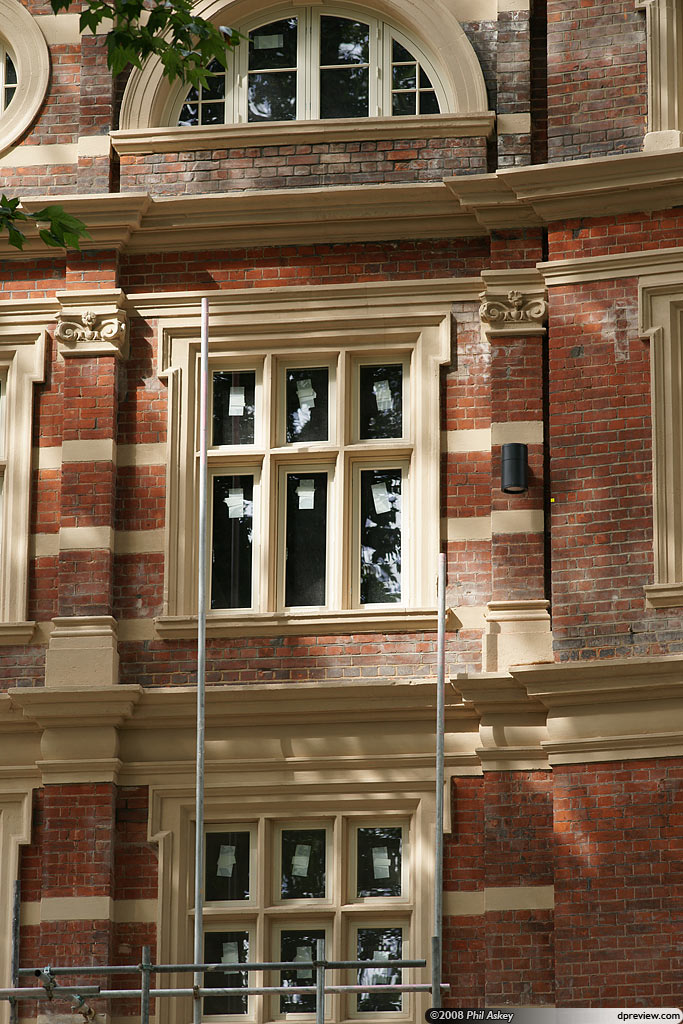
Sony Alpha 900 Preview Samples (38 of 39), 70 mm equiv, ISO 200, 1/640 sec, F8.0, +0.0 EV, Sony 24-70mm f2.8 ZA
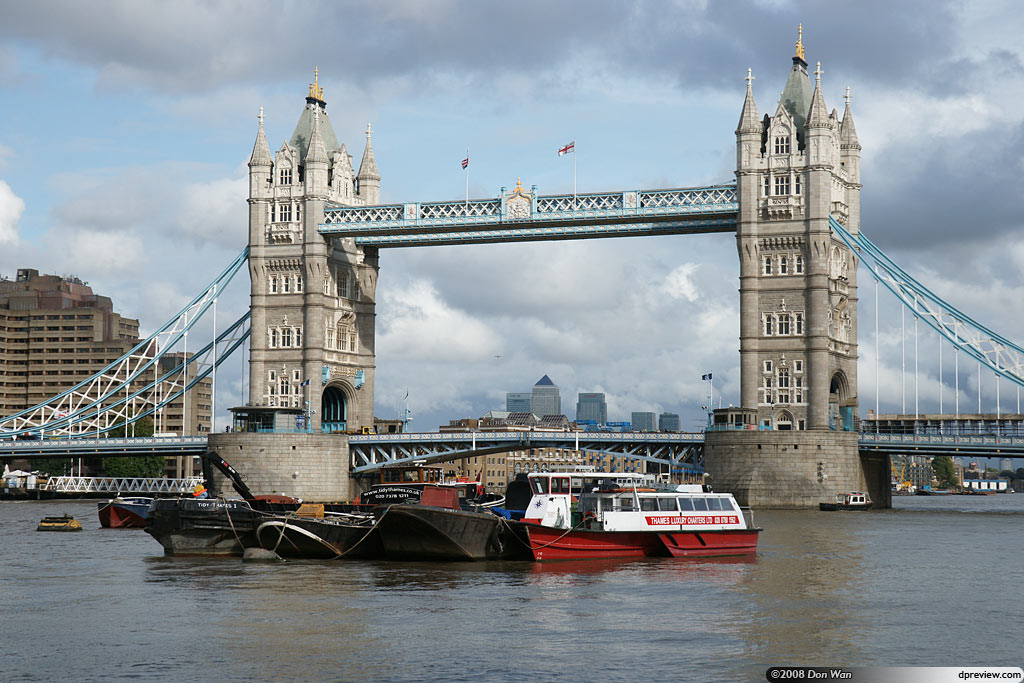
출저, 샘플사진 : dpreview.com
그 이름은 A900
35mm 대비 1:1 CMOS
2400만화소로 무장된 A900 가격또한 3000불.....(약300만원돈)
가격대비 최고의 화소수를 자랑하는....
듀얼크로스센서 9개 나머지 측거점 10개 해서 총 19개 측거점...
연사 5연사...
듀얼 메모리 지원 CF, 메모리스틱듀오..
바디 내장 손떨림 보정...(이건 정말 부럽다는...)
단점으로 노이즈가 많다는걸 지적하려고 했으나....
어떤분의 글을 보고 노이즈가 단점이 아니라고 생각이 되네요.
이유는... 바디의 활용성에 따라 달르다고 생각됩니다.
D3 같이 프레스쪽이 집중된 바디는 AF와 고감도 노이즈가 잘 되어있어야..
하지만..
A900의 활용성은 스튜디오쪽으로 생각하고 만든 바디이기때문에..
노이즈면 보다는.....
화질, 디테일, 계조, DR 모든 측면을 최고로 좋게 하기 위해서...
노이즈를 줄이지 않는 걸로 생각되서 그렇습니다.
머 카메라야 자기 쓰기 나름이니......
'Information > Information' 카테고리의 다른 글
| AF-S DX NIKKOR 10-24mm F3.5-4.5G ED (0) | 2009.04.15 |
|---|---|
| 니콘의 새로운 보급기 D5000 (0) | 2009.04.15 |
| 한번의 클릭으로 윈도우XP 최적화 레지스트리 병합 파일 (0) | 2008.12.21 |
| Nikon AF-S Nikkor 50mm f/1.4G lens (0) | 2008.09.22 |
| Canon EOS 5D Mark II: 21MP and HD movies (0) | 2008.09.17 |




